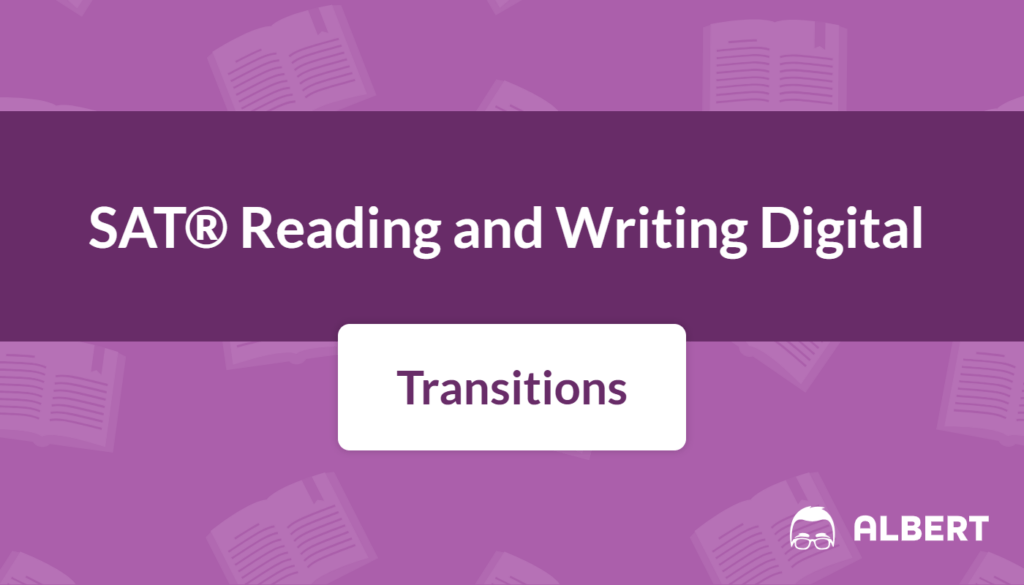What We Review
Mastering Transitions for the SAT® Reading and Writing Test
Transitions are powerful tools in writing. They guide readers through ideas, making each point easier to follow. This article explores the importance of transitions, how to use them effectively, and how to identify them on the SAT® Reading and Writing Test. By practicing with clear examples and exercises, students can begin writing with greater clarity and flow.
Introduction
Transitional words and phrases help connect thoughts within and between sentences. They act like bridges that link ideas, smoothing out sudden jumps in information. When a passage lacks such bridging words, it can feel choppy or confusing.
For the SAT® Reading and Writing Test, mastering transitions is essential. Test questions may ask about which transition best fits a sentence, or how to revise a passage for clarity. Understanding how to choose the right transition improves a writer’s ability to guide readers and meet specific rhetorical goals. Therefore, consistent practice is key.
Understanding Transitions
Transitions are words or phrases that link ideas, sentences, or paragraphs. They show relationships, such as comparisons, contrasts, or sequences. Consider transitions as signals that alert readers to a new or related idea.
- Transitions improve readability: They help readers keep track of an argument’s direction.
- They create flow: A well-placed transition can connect ideas without abrupt breaks.
Example
Imagine reading a story with every sentence placed randomly, without warning. It would be confusing. However, transitions like “meanwhile” or “on the other hand” guide readers from one point to the next. That guidance makes a piece more engaging.
Step-by-Step Solution for Understanding This Example
- Identify the problem: Abrupt changes in ideas can confuse readers.
- Observe the solution: Using transitions such as “however” introduces a contrast or shift.
- Notice the improvement: The sentence becomes more coherent and easy to follow.
Types of Transitional Words and Phrases
Transition words come in various categories, each serving a unique purpose. Knowing these categories helps writers choose the best transitions for each situation.
Addition Transitions
These words add more ideas or information in a text.
Common examples:
- additionally
- furthermore
- moreover
Contrast Transitions
Use these when showing how ideas differ from each other.
Common examples:
- however
- on the other hand
- conversely
Cause and Effect Transitions
These indicate that one idea is a result of another.
Common examples:
- therefore
- consequently
- as a result
Sequence Transitions
These clarify the order of events or steps in a process.
Common examples:
- first
- next
- finally
Example
Consider this pair of sentences:“I wanted to go to the park. It was raining.”
It feels incomplete because there is no link between wanting to go out and encountering rain. By inserting a contrast transition, the message becomes clearer:
“I wanted to go to the park; however, it was raining.”
Step-by-Step Solution for This Example
- Pinpoint the relationship: The second sentence contradicts the desire to go outside.
- Choose a transition: “However” signals a contrast.
- Insert the word: Place “however” after the semicolon or at the start of the second clause.
- Read the revised sentence: Confirm that it now flows and shows the difference between the two ideas.
How to Use Transitional Words Effectively
Effective transition use goes beyond memorizing word lists. The placement and accuracy of a transition are equally important.
Placement Within Sentences
Transitions can appear at the start, middle, or end of a sentence. However, their position must match the meaning intended. For instance, starting a sentence with “however” indicates a shift from a previous statement. Placing it in the middle might suggest a continued point with a twist.
Choose the Right Relationship
When connecting ideas, writers must confirm if the ideas are additive, contrasting, or cause-and-effect. That choice ensures the correct transition is used.
Example
Original: “She loves to read. She doesn’t have time for it.”
Revised: “She loves to read; however, she doesn’t have time for it.”
Step-by-Step Solution for This Example
- Analyze the ideas: The second statement contradicts the first.
- Determine the type of transition: Contrast is needed.
- Insert transition: “However” shows opposition.
- Check for clarity: The sentence now reveals a love of reading yet a lack of opportunity.
Strategies for Identifying Transitions on the SAT®
Read the Passage First
Always read an entire passage or paragraph before selecting a transition. This broader context helps identify the intended relationship between statements.
Look for Key Words and Clues
Terms such as “but,” “not only,” or “as a result” may signal the type of transition needed. Also, watch for sentences that contrast or build on previous points.
Practice with Sample Questions
Familiarize yourself with how the SAT® tests transitions. Questions often ask for the best linking word between sentences.
Example Practice Question
“Many students enjoy math; __________, some find it challenging.”
Options:
- a) however
- b) furthermore
- c) similarly
The correct answer is (a) however.
Step-by-Step Solution for This Example
- Identify the relationship between the clauses: Enjoying math vs. finding it challenging.
- Recognize the contrast: The two ideas show differing views of math.
- Select the correct transition type: Contrast transitions (“however,” “nevertheless,” “on the other hand”).
- Confirm the choice: “However” fits best, as it clearly shows contradiction.
Creating a Transition Word List
Having a categorized list of transitions is helpful for quick reference. This list allows students to see how each transition fits into different contexts.
| Type | Transition Words |
| Addition | Additionally, Furthermore, Also, Moreover |
| Contrast | However, On the contrary, Yet, Conversely |
| Cause and Effect | Therefore, Consequently, Thus, As a result |
| Sequence | First, Next, Finally, Then |
These lists save time when analyzing practice tests or revising essays. In addition, color-coding them can make studying more engaging and memorable.
Practicing Transition Use in Writing
Consistent practice is the best way to remember and apply transitions. Writing short paragraphs with different transition types helps build mastery.
Drafting Exercises
- Choose a topic: For instance, write about a weekend hobby.
- Outline main points: Decide what facts or claims to include.
- Insert transitions: Add at least one addition, one contrast, and one cause-effect transition.

Peer Review
Sharing written paragraphs with classmates or friends is beneficial. Ask a reviewer to highlight where transitions make sense and where additional clarity might be needed. In many cases, another person’s perspective spots gaps that the writer missed.
Example Writing Prompt
Write a short paragraph about a favorite hobby. Use at least three types of transitions (addition, contrast, cause-effect, or sequence).
Step by Step Solution
Paragraph Example:
“Playing the guitar is a relaxing pastime because it helps reduce stress. Therefore, it can be an excellent way to unwind after a long day of classes. However, mastering new songs can be challenging at first. Nevertheless, consistent practice improves both technique and confidence.”
Solution Analysis:
- “Because” links the hobby to a reason (cause and effect).
- “Therefore” adds a result of the relaxing effect.
- “However” signals a contrast—learning new material is tough.
- “Nevertheless” shifts back to encouragement, showing another contrast or concession.
Quick Reference Chart: Important Vocabulary and Concepts
Below is a small chart with key terms and their definitions. Copy and paste this chart into a document for easy reference:
| Term | Definition |
| Transition | A word or phrase used to connect ideas smoothly |
| Addition | A transition function that adds similar ideas (e.g., “Furthermore”) |
| Contrast | A transition function that shows opposing or different ideas (e.g., “However”) |
| Cause and Effect | A transition function that indicates a result or consequence (e.g., “Therefore”) |
| Sequence | A transition function that clarifies the order or steps of an event (e.g., “First,” “Next”) |
Conclusion
Transitions are key elements for clarity and coherence in writing. They guide readers from one point to another, ensuring that every argument or claim feels connected. On the SAT® Reading and Writing Test, knowing how to use these bridging words effectively can improve scores and highlight strong rhetorical skills.
Remember to practice regularly, whether by revising old essays or working on sample questions. This habit builds the muscle memory needed to choose precise and effective transitions. By doing so, students will develop writing that flows smoothly and communicates ideas with confidence.
Consider creating your own personalized transition word list geared toward common SAT® prompts. Review passages that already use transitions effectively, and notice how they strengthen the argument. By consistently applying these strategies, students can gain assurance that their writing meets specific rhetorical goals and flows seamlessly. Good luck with continued practice, and keep refining those transition skills!
Sharpen Your Skills for SAT® Reading and Writing
Are you preparing for the SAT® Reading and Writing test? We’ve got you covered! Try our review articles designed to help you confidently tackle real-world SAT® Reading and Writing problems. You’ll find everything you need to succeed, from quick tips to detailed strategies. Start exploring now!
- SAT® Grammar Rules: SAT® Reading and Writing Review
- SAT® Punctuation Rules: SAT® Reading and Writing Review
- Rhetorical Synthesis: SAT® Reading and Writing Review
Need help preparing for your SAT® Reading and Writing exam?
Albert has hundreds of SAT® Reading and Writing practice questions and full-length practice tests to try out.








